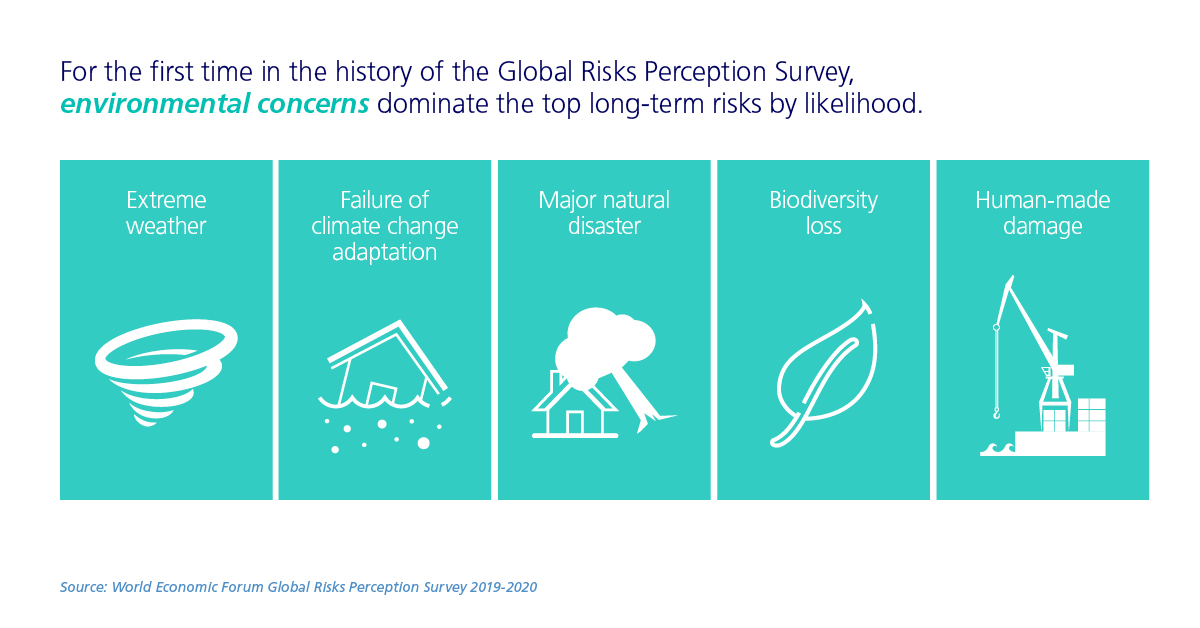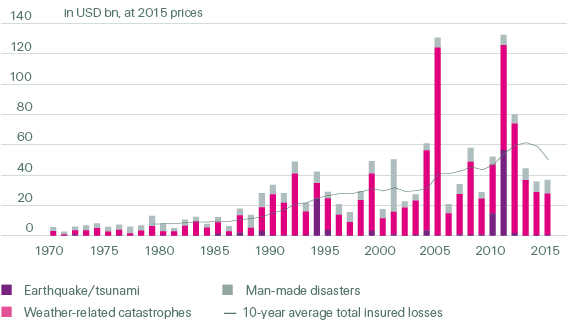Concerns about climate-risks increase have growth since 2015. The 2020 Global Risks Report indicates that climate risks are not only very likely, but they would also significantly impact in society and businesses. For the first time,environment became the first concern in the long-term risks. Climate-action failure, due to economical considerations, is another important global concern.

We must expect a significant climate risks increase in the near future. These risks would be greater than those associated with historical series.
Risk impact analyses should be more frequently conducted. They can follow ISO 22301 standard or similar instruments. Businesses could increase their climate resilience through Risk management plans. Those risk plans will help to increase climate resilience, despite of the eventual rise in climate variability.
Insurance companies have pointed out climate risks increase and associated losses.

According to a report from Swiss Re, the number of meteorological and hydrological events has significantly increased since 1980. However, geological and climatological events remain in the same number.
The World Bank points the absolute need to integrate climate risk management into development strategies, especially in developed countries.
According to World Bank, climate risks equally affect developed and developing countries. The impact could be significant in countries with high GDP growth, due to unreliable investments. However, poor countries usually have little capacity to deal with disasters. These countries will suffer the most severe consequences from climate risks increase.
It is essential to create climate resilience developing risk management plans, especially in places where the climate impacts may be greater.
The World Bank and other international entities will finance such climate risk impact assessments, specially in resource-poor countries.

The Green Climate Fund (GCF), for instance, is a financial mechanism under the United Nations Framework Convention on Climate Change (UNFCCC) that helps developing countries reduce greenhouse gas emissions and enhance their ability to respond to climate change.
The World Bank is an accredited entity of the GCF, which means it can access and manage GCF resources to support climate change projects in developing countries.
The World Bank also has its own climate change programs and initiatives, such as the Climate Investment Funds and the Partnership for Market Readiness, which complement its work with the GCF. Together, these efforts aim to mobilize finance and provide technical assistance to support developing countries in their transition to low-carbon and climate-resilient development.
Some governments started to provide business and institutions with the required support for climate impact assessments.
For instance, the British Meteorological Office (Met Office) has opened a “Framework Center for Impact and Climate Risk Studies” (CIRF). The office has published a document to support climate risk assessments. It provides guidelines and data for climate impact studies .
Climate change and climate variability are related phenomena. Heat waves such as that suffered in Europe in 2003 might be “normal” after 2070. However, it is difficult to associate a particular extreme event with global warming.
Traffic on a motorway could be an example to better understand the relationship between climate change and extreme events. Speeding on a motorway does not mean that an accident will occur. However, if many motorists are speeding on a motorway, it will undoubtedly increase the accident likelihood, as well as the death rates by each accident.
Global warming provides more energy to the ocean-earth-atmosphere system and therefore it increases the frequency and intensity of extreme events.

